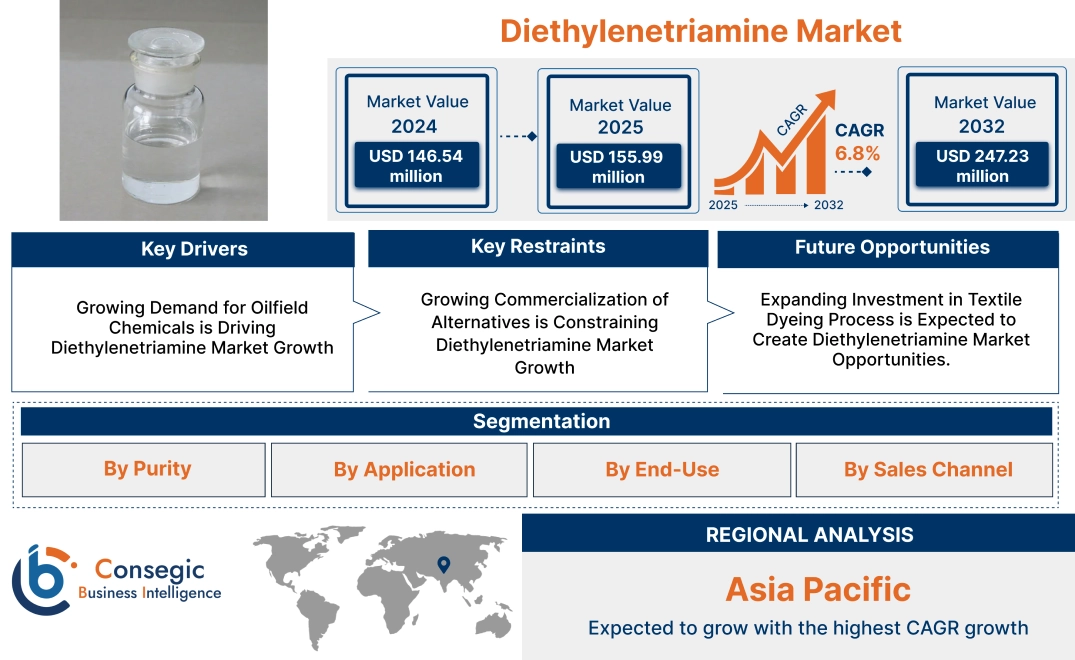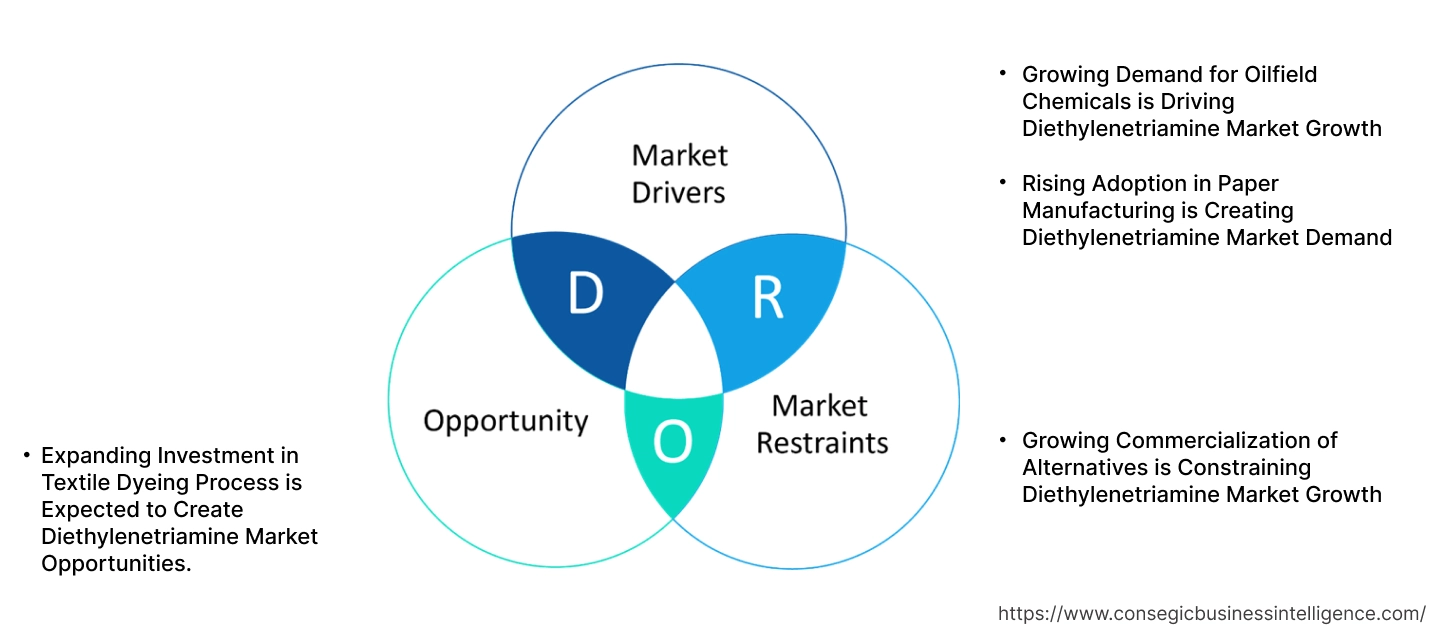- Summary
- Table Of Content
- Methodology
Diethylenetriamine Market Size:
The diethylenetriamine market size is growing with a CAGR of 6.8% during the forecast period (2025-2032), and the market is projected to be valued at USD 247.23 million by 2032 from USD 146.54 million in 2024. Additionally, the market value for 2025 is attributed to USD 155.99 million.
Diethylenetriamine Market Scope & Overview:
The diethylenetriamine (DETA) is an organic compound with the formula HN(CH₂CH₂NH₂). It appeared as a colorless, hygroscopic liquid with an ammonia-like odor. This compound is available in both low purity (<98%) and high purity (≥98%). It is readily soluble in both water and organic solvents. DETA is used in applications such as chelating agents, wet-strength resins, oilfield chemicals, lubricant oil additives, and others. In addition to this, it offers several advantages such as high reactivity, strong metal complexity, and amine functionality. Due to this, it is used in various sectors such as petrochemical, pulp and paper, textile, cosmetics and personal care, and others. Moreover, this compound is distributed through direct and indirect sales channels to sales to petrochemical companies, textile manufacturers, paper manufacturing units amongst others.
Key Drivers:
Growing Demand for Oilfield Chemicals is Driving Diethylenetriamine Market Growth
The diethylenetriamine is used as a building block for imidazoline-based corrosion inhibitors in oilfield chemicals. It also improves the performance and durability of asphalt modification additives in oilfield chemicals production. Moreover, companies are investing in oilfield chemicals due to growing energy consumption, increasing transportation, and government support, furthermore, driving the market.
- In 2022, Halliburton started oilfield chemical manufacturing plant in Saudi Arabia. This is leading to increased oilfield chemical production thereby driving the use of diethylenetriamine for building imidazoline-based corrosion inhibitors and to improve the durability of asphalt modification additives.
Hence, growing demand for oilfield chemicals is leading to diethylenetriamine market expansion.
Rising Adoption in Paper Manufacturing is Creating Diethylenetriamine Market Demand
In paper manufacturing, diethylenetriamine is used to improve fiber retention and drainage leading to better paper formation and reduced water consumption. It also helps in the removal of suspended solids, heavy metals, and organics contaminants in the paper mill effluent treatment. The investment in paper production is growing due to increasing use of paper for printing and sustainable packaging, furthermore, driving the market.
- In 2024, Georgia-Pacific invested USD 150 Million in paper manufacturing in United Sates. This results in more paper production, thereby driving the use of diethylenetriamine for the removal of suspended solids and heavy metals.
Hence, rising adoption in paper manufacturing is creating diethylenetriamine market demand.
Key Restraints:
Growing Commercialization of Alternatives is Constraining Diethylenetriamine Market Growth
The commercialization of alternative compounds such triethylenetetramine and ethylenediamine amongst others is growing. They provide similar functions to that of diethylenetriamine. The triethylenetetramine is widely used in epoxy resins and paper production due to its lower production costs and greater availability. Furthermore, ethylenediamine is preferred in wet-strength resins due to superior tear resistance and breaking properties. Additionally, aminopolycarboxylates such as ethylenediaminetetraacetic acid and nitrilotriacetic acid are used in adhesives and lubricant oil additives due to better biodegradation rate and high thermal stability.
Hence, the growing commercialization of alternatives is constraining market growth due to low production cost, biodegradability, and greater availability.
Future Opportunities:
Expanding Investment in Textile Dyeing Process is Expected to Create Diethylenetriamine Market Opportunities.
Textile dyeing is the process of applying color to textile using dyes to achieve the desired color and colorfastness. In this process, diethylenetriamine is used as a dye-fixing agent, improving color fastness and the overall quality of dyed textiles. Its reactivity with textile fibers allows for crosslinking, which leads to better dye retention and improved durability of the dyed fabric. Moreover, investment in textile dying is growing significantly due to increased consumer demand for diverse and trendy colors along with the development of new technologies.
- In 2025, According to The Textile Magazine, Nitin Spinners invested USD 1.1 Billion in its textile dying process in India. This will lead to more textile dyeing thereby creating market opportunities to improve color fastness and overall quality of dyed textiles.
Hence, expanding investment in textile dying process is expected to create diethylenetriamine market opportunities.
Diethylenetriamine Market Segmental Analysis :
By Purity:
Based on Purity, the market is categorized into low purity (<98%) and high purity (≥98%).
Trends in Purity:
- According to diethylenetriamine market trends, high purity compound is extensively used in chemical reactions and metal ore floatation.
- Adoption of low purity compound is growing in detergents to enhance cleaning efficiency as per market trends.
The high purity (≥98%) segment accounted for the largest market share in the year 2024.
- The high purity (≥98%) diethylenetriamine compound is free from significant impurities, ensuring its effectiveness and safety.
- It is used in various chemical reactions and as a building block for other compounds.
- This compound is also utilized in the mining sector, particularly in copper and nickel ore flotation, to depress pyrrhotite and control metal concentrations.
- Furthermore, demand for copper is increasing, driven by the global transition to renewable energy, the rise of electric vehicles and expansion of digital devices. To cater this, companies are investing in copper production.
- For instance, Vedanta Ltd. invested USD 2 Billion in copper projects in Saudi Arabia. This is leading to more copper production, thereby driving the use of high purity diethylenetriamine compound depress pyrrhotite and control metal concentrations.
- Hence, as copper production is growing, the need for this compound is also increasing, in turn driving the segment.
The low purity (<98%) segment is expected to grow at the fastest CAGR over the forecast period.
- The low purity (<98%) diethylenetriamine compound contains slightly more impurities as compared to the high purity grade.
- It is used as a cement grinding aid and in the production of imidazoline-based corrosion inhibitors.
- This compound is also utilized in detergents to enhance cleaning efficiency and improve the overall performance of detergents.
- Furthermore, the use of detergents is fueled by increasing consumer awareness of health and hygiene along proliferation of washing machines. To cater this, manufacturers are increasing their detergent production. This will lead to more adoption of low purity diethylenetriamine compound in detergents to enhance cleaning efficiency.
- Hence, as the adoption of detergents is growing, the need for this compound will also increase. This will drive the segment for the forecasted years.
By Application:
Based on Application, the market is categorized into chelating agents, wet-strength resins, oilfield chemicals, lubricant oil additives, and others.
Trends in Application:
- The diethylenetriamine compound is extensive utilized as a chelating agent to control metal ion concentrations.
- Adoption of diethylenetriamine is growing in lubricant oil additives to improve their friction as per market trends.
The chelating agents segment accounted for the largest market share in the year 2024.
- Chelating agents are chemical compounds that form stable bonds with metal ions and prevent them from reacting with other substances.
- The DETA is used as a chelating agent to control metal ion concentrations in ores and solutions.
- It also helps to remove heavy metals such as copper, nickel, zinc, lead, and mercury from wastewater.
- Furthermore, water scarcity, climate change and urbanization is growing along with water pollution. To cater for this, the countries are investing in wastewater treatment.
- For instance, in 2024, United States Section of the International Boundary and Water Commission launched South Bay International Wastewater Treatment Plant. This plant treated 25 million gallons of wastewater per day, thereby driving the use of DETA compound for heavy metal removal from wastewater.
- Hence, as investment in wastewater is growing, the need for this compound is also increasing, in turn driving the segment.
The lubricant oil additives segment is expected to grow at the fastest CAGR over the forecast period.
- Lubricant oil additives are chemical compounds added to base oils to enhance their viscosity, corrosion resistance, and other properties.
- In these additives, DETA compound is used in the production of dispersants which prevents sludge and deposits formation in the oil.
- It also enhances the anti-wear properties of lubricant oil additives forming protective films on metal surfaces.
- Further, the adoption of lubricant oil additives is growing due to increasing vehicle production and stringent environmental regulations. To cater for this, manufacturers of lubricant oil additives is increasing their production, this will lead to more use of DETA compound to enhance anti-wear properties.
- Hence, as adoption of lubricant oil additives is growing, the need for this compound will also increase. This will drive the segment for the forecasted years.
By End-Use:
Based on End-Use, the market is categorized into petrochemical, pulp and paper, textiles, cosmetics and personal care, and others.
Trends in End-Use:
- As per diethylenetriamine market trends, this compound is extensively used in petrochemical products such as corrosion inhibitor and epoxy resins.
- Adoption of diethylenetriamine is growing in the production of fabric softeners to create cationic fatty acid softening agents.
The petrochemical segment accounted for the largest market share of 34.18% in the year 2024.
- In the petrochemical sector, DETA is used as a corrosion inhibitor, protecting metal surfaces in industrial cooling systems and oilfield applications.
- It is also utilized in epoxy reins to transform the liquid epoxy resin into a solid, cross-linked polymer.
- Furthermore, the adoption of epoxy resins is growing due to rising construction and expanding use of electronics. To cater this, companies are investing in epoxy resin manufacturing.
- For instance, SOMAR invested USD 2.5 Million in epoxy resin manufacturing plant in West Virginia. This is leading to more epoxy resin production, thereby driving the use of DETA compound for transformation of liquid epoxy into polymer.
- Hence, as production of epoxy resin is growing, the need for this compound is also increasing, in turn driving the segment.
The textile segment is expected to grow at the fastest CAGR over the forecast period.
- In textile sector, diethylenetriamine is used in formulations for antibacterial treatments, especially for sportswear and medical textiles.
- It is also utilized as a raw material in the production of fabric softeners to create cationic fatty acid softening agents.
- Furthermore, the adoption of fabrics softeners is growing due to increasing consumer awareness of fabric care, the desire for long-lasting fragrance, and product innovations. To cater this, textile companies are increasing their fabric softeners production, leading to more use of diethylenetriamine compound.
- Hence, as production of fabric softeners is growing, the need for this compound is also increasing. This will drive the segment for the forecasted years.
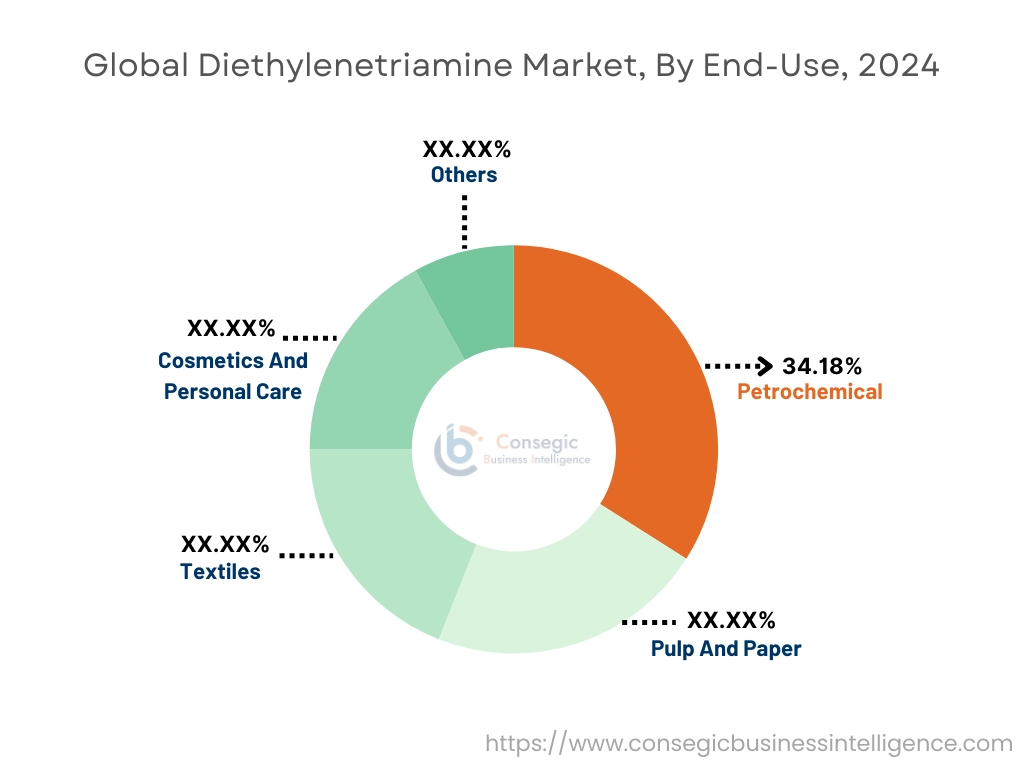
By Sales Channel:
Based on Sales Channel, the market is categorized into direct sales and indirect sales.
Trends in Sales Channel:
- Direct sales channel provides strong brand identity and complete control over the supply chain.
- Adoption of indirect sales channel is growing due to proliferation of retailers due to low storage costs as per market trends.
The direct sales segment accounted for the largest market share in the year 2024.
- Direct sales is a type of sales channel where products are sold directly to customers without any intermediaries.
- The diethylenetriamine compound is widely sold through direct sales to petrochemical companies, textile manufacturers and paper manufacturing units amongst others. They prefer direct sales due to strong brand identity and direct interaction with manufacturers.
- Furthermore, direct sales channel leads to complete control over the supply chain and faster product delivery. Due to this, customers prefer direct sales for the procurement of this compound.
- Hence, as customers are preferring faster product delivery, the adoption of direct sales is increasing, in turn driving the segment.
The indirect sales segment is expected to grow at the fastest CAGR over the forecast period.
- Indirect sales is a type of sales channel where products are sold through intermediaries such as distributors, retailers or agencies.
- It furthermore includes retail sales and online sales where diethylenetriamine compound is sold through retailers or through online marketplaces.
- Moreover, retail sales offer advantages such as less inventory, faster movement of products and lower storage costs. This is leading to more retail sales in countries.
- According to S. Department of Commerce, the retail sales in United States is increased by 3.1% in 2025 as compared to the year 2024. This includes diethylenetriamine which is distributed through retailers to oil & gas manufacturers, petrochemical companies, and paper manufacturers.
- Hence, as preference for retail sales is growing, the adoption of indirect sales is also increasing. This will drive the segment for the forecasted years.
Regional Analysis:
The regional segment includes North America, Europe, Asia Pacific, Middle East & Africa, and Latin America.
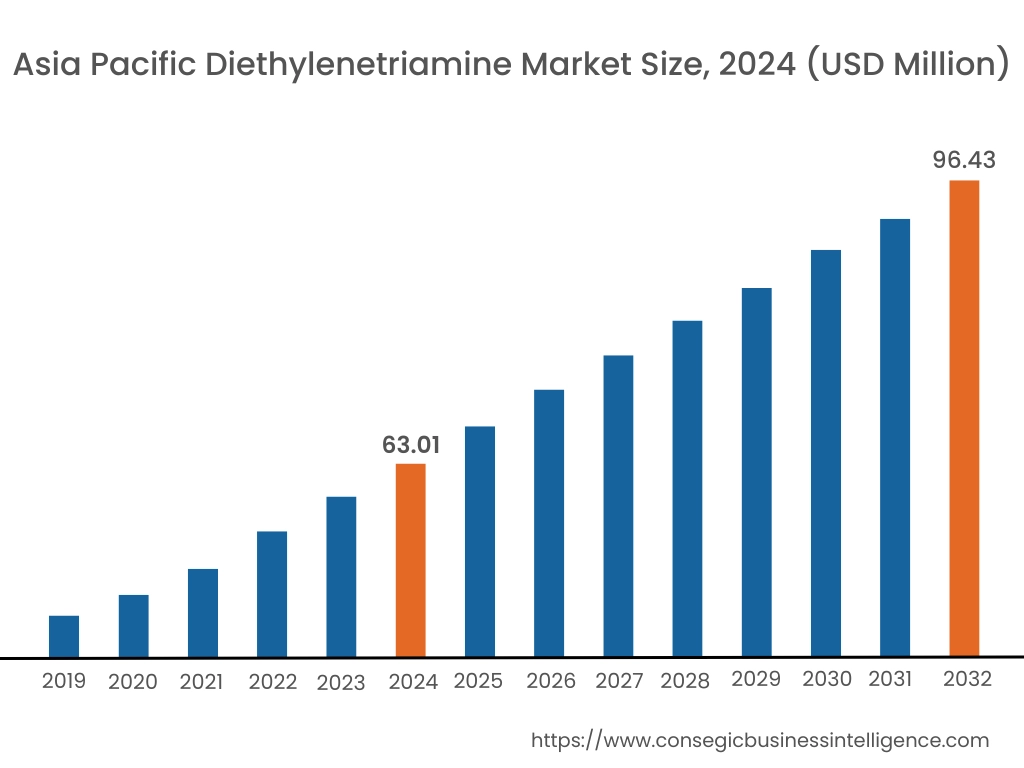
In 2024, Asia Pacific accounted for the highest market share at 43.00% and was valued at USD 63.01 Million and is expected to reach USD 96.43 Million in 2032. In Asia-Pacific, the China accounted for the highest diethylenetriamine market share of 36.67% during the base year of 2024. As per analysis, the Asia Pacific region holds a dominant position in the market due to expanding petrochemical sector. In this sector, diethylenetriamine is used as fuel additive to improve the stability of fuels, preventing degradation and ensuring better performance. It also prevents corrosion in fuel tanks and lines, extending the lifespan of fuel systems. Moreover, in the countries such as China, India, Japan, and South Korea, companies are investing in investing in food processing sector, furthermore, driving the market growth.
- In 2022, BASF opened new production plant for fuel additives in China. This is leading to more production of fuel additives, thereby driving the use of diethylenetriamine to improve the stability of fuels.
Therefore, due to the above-mentioned factors, the Asia Pacific region is dominating in the market as per analysis.
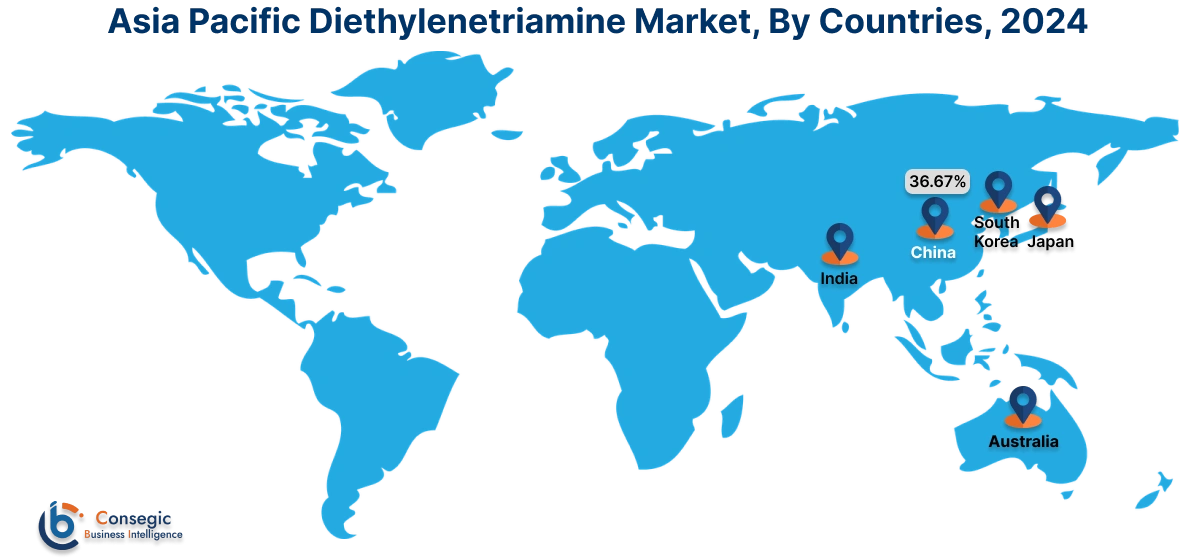
Europe is expected to witness the fastest CAGR of 9.3% over the forecast period of 2025-2032. According to diethylenetriamine market analysis, Europe region is growing considerably in the market driven by pulp and paper sector. In this sector, diethylenetriamine is used in the dispersion of fillers and pigments in paper coating, enhancing printability and surface properties. It is also utilized in the production of polyamides which enhances the wet strength of paper products such as tissues and paper towels. Additionally, countries such as Germany, France, and United Kingdom are major contributors in the market due to strong investment in paper production. Hence, diethylenetriamine market share of Europe is expected to emerge rapidly through expansion of pulp and paper sector as per analysis.
According to diethylenetriamine market analysis, the North America region is growing considerably in the market driven by technological advancements. Advancement in hydrolysis and purification processes have enhanced the efficiency, sustainability, and cost-effectiveness of diethylenetriamine compound. Innovations in automation and artificial intelligence driven process control are optimizing production and ensuring high-performance compound for fuel additives and fabric softeners. This is furthermore fueling the market growth in the region.
The Middle East & Africa region is experiencing moderate growth in the market, driven by expanding the cosmetics and personal care industry. Diethylenetriamine is used in the production of cationic polymers, which enhances softness, manageability, and anti-static properties of hair care products. It is also utilized in skin care formulations to stabilize emulsions in lotions and creams. The population in the region is increasingly adopting cosmetics and personal care products, furthermore, driving the market growth.
As per analysis, the market in Latin America is driven by textile industry. The diethylenetriamine is used to synthesize flame retardant for cotton fabrics, improving their flame retardancy and durability. It is also utilized as a textile additive, specifically for dyeing and printing processes of textiles. Additionally, in countries such as Brazil, Argentina, and Chile, textile manufacturing plants are expanding. This is leading to diethylenetriamine market expansion across the region.
Top Key Players & Market Share Insights:
The diethylenetriamine industry is highly competitive with major players providing products to the national and international markets. Key players are adopting several strategies in research and development (R&D) and product innovation to hold a strong position in the global diethylenetriamine market. Key players in the diethylenetriamine industry include-
Diethylenetriamine Market Report Insights:
| Report Attributes | Report Details |
| Study Timeline | 2019-2032 |
| Market Size in 2032 | USD 247.23 Million |
| CAGR (2025-2032) | 6.8% |
| By Purity |
|
| By Application |
|
| By End-Use |
|
| By Sales Channel |
|
| By Region |
|
| Key Players |
|
| North America | U.S. Canada Mexico |
| Europe | U.K. Germany France Spain Italy Russia Benelux Rest of Europe |
| APAC | China South Korea Japan India Australia ASEAN Rest of Asia-Pacific |
| Middle East and Africa | GCC Turkey South Africa Rest of MEA |
| LATAM | Brazil Argentina Chile Rest of LATAM |
| Report Coverage |
|
Key Questions Answered in the Report
How big is the diethylenetriamine market? +
In 2024, the diethylenetriamine market is USD 146.54 Million.
Which is the fastest-growing region in the diethylenetriamine market? +
Europe is the fastest-growing region in the diethylenetriamine market.
What specific segmentation details are covered in the diethylenetriamine market? +
Purity, Application, End-Use and Sales Channel are covered in the diethylenetriamine market.
Who are the major players in the diethylenetriamine market? +
BASF (Germany), Nouryon (Netherlands), and SABIC (Saudi Arabia) are some of the major players in the market.
